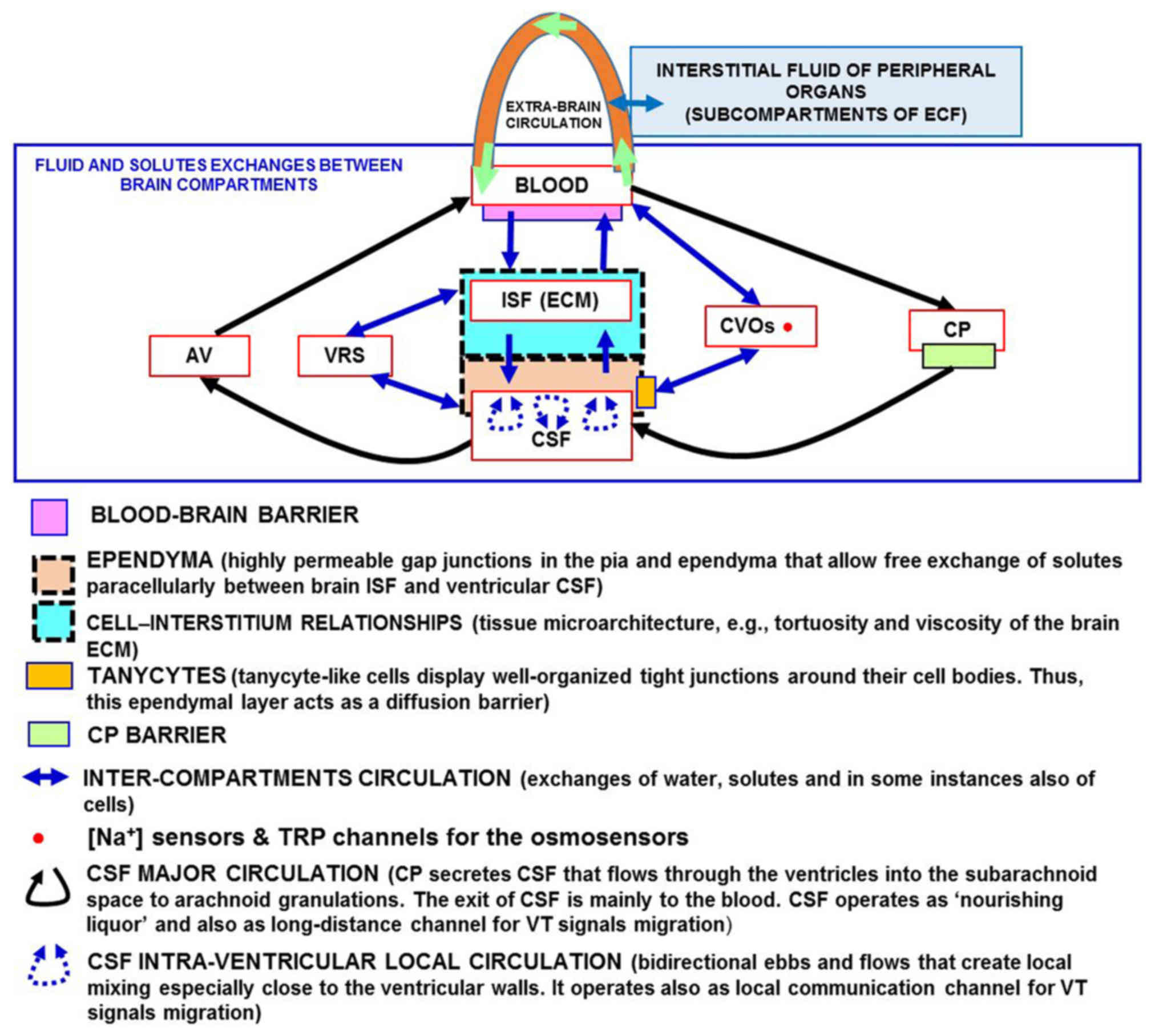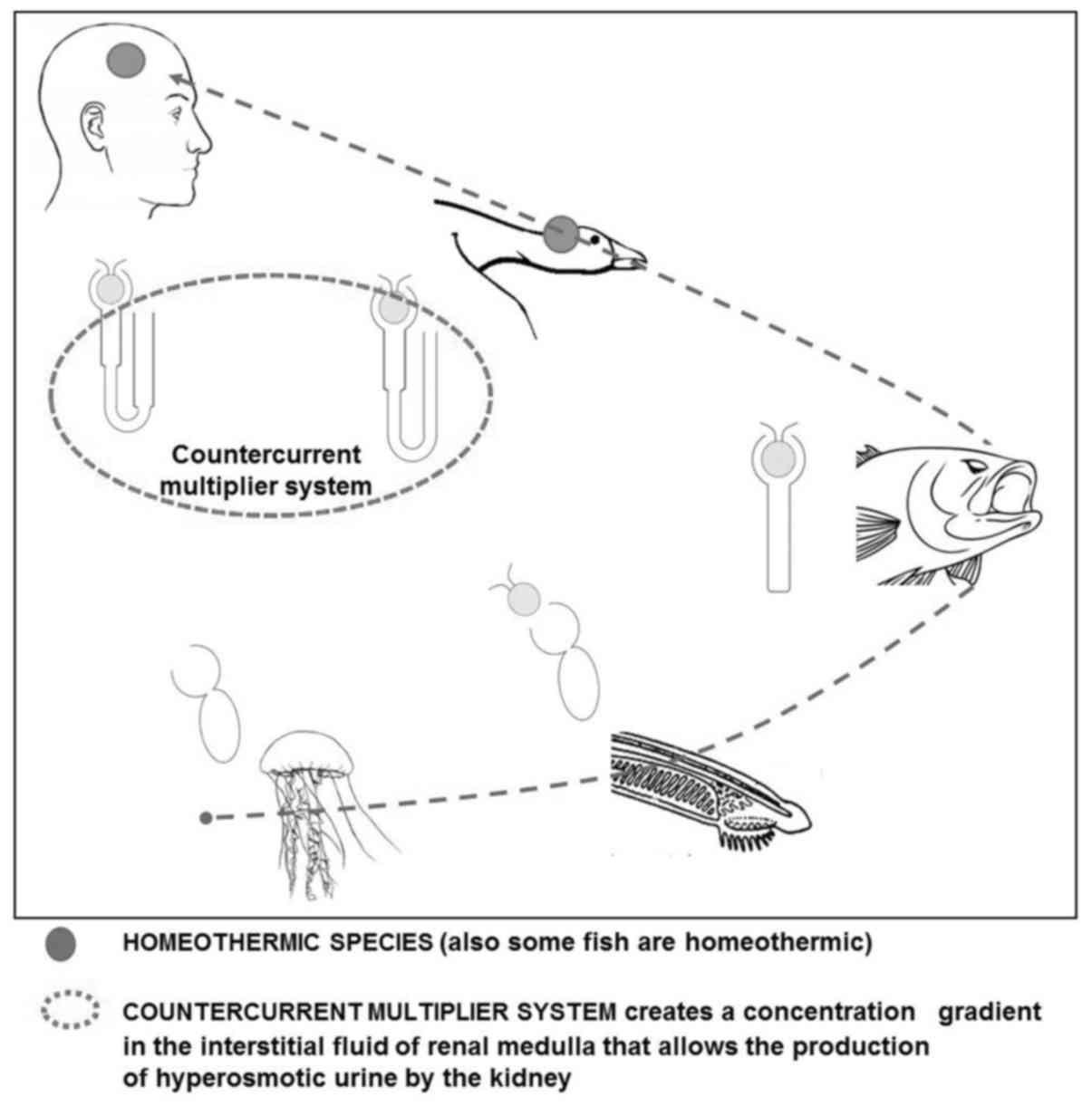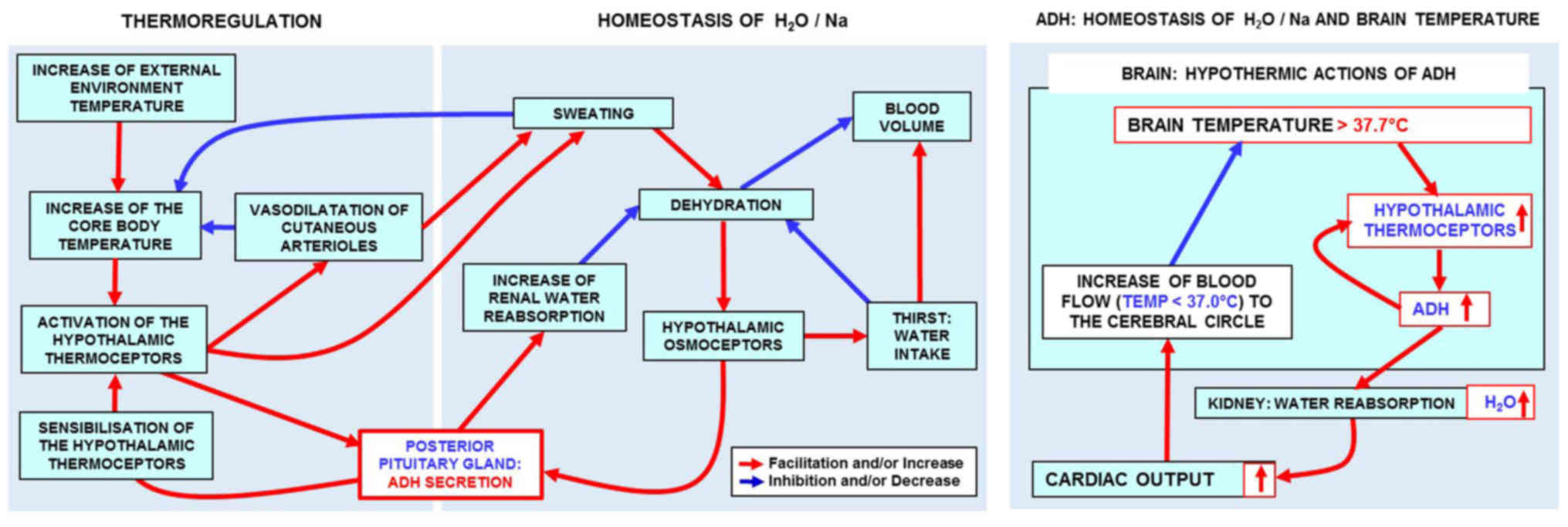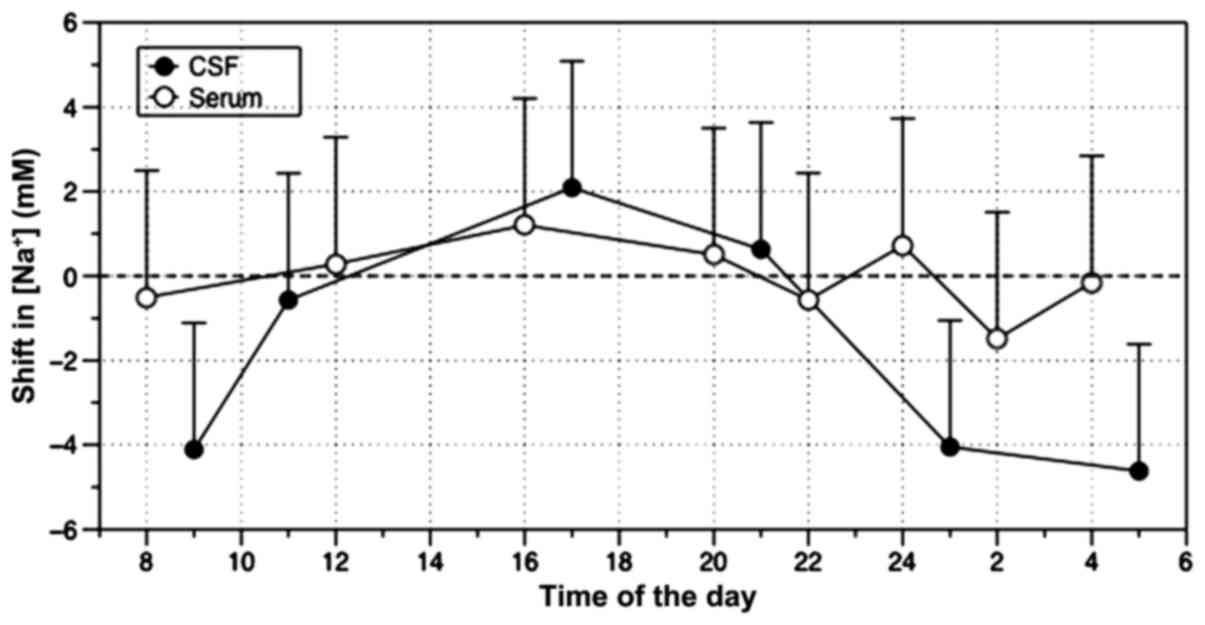|
1
|
Schulkin J: Rethinking homeostasis:
allostatic regulation in physiology and pathophysiology. MIT Press;
Cambridge: 2003
|
|
2
|
McEwen BS and Wingfield JC: The concept of
allostasis in biology and biomedicine. Horm Behav. 43:2–15. 2003.
View Article : Google Scholar : PubMed/NCBI
|
|
3
|
Berntson GG and Cacioppo JT: Integrative
physiology: homeostasis, allostasis and the orchestration of
systemic physiology in handbook of psychophysiology. Cambridge
University Press; 3rd edition. pp. 433–452. 2007
|
|
4
|
Smith HW: From Fish to Philosopher. 18th
edition. Little, Brown; Boston: 1953
|
|
5
|
Danziger J and Zeidel ML: Osmotic
homeostasis. Clin J Am Soc Nephrol. 10:852–862. 2015. View Article : Google Scholar :
|
|
6
|
Noda M and Sakuta H: Central regulation of
body-fluid homeostasis. Trends Neurosci. 36:661–673. 2013.
View Article : Google Scholar : PubMed/NCBI
|
|
7
|
Sterling P and Eyer J: Allostasis: A new
paradigm to explain arousal pathology: handbook of life stress,
cognition, and health. Fisher S and Reason JT: Wiley; Chicester:
pp. 629–649. 1988
|
|
8
|
Schulkin J: Social allostasis:
Anticipatory regulation of the internal milieu. Front Evol
Neurosci. 2:1112011. View Article : Google Scholar : PubMed/NCBI
|
|
9
|
Vanzago L: Breve storia dell'anima. Il
Mulino, Bologna: 2009, in Italian.
|
|
10
|
Prata MR: Normal and pathologic in Freud.
Physis. 9:37–81. 1999. View Article : Google Scholar
|
|
11
|
Borrow AP, Stranahan AM, Suchecki D and
Yunes R: Neuroendocrine regulation of anxiety: Beyond the
hypothalamic-pituitary-adrenal axis. J Neuroendocrinol. 28:2016.
View Article : Google Scholar : PubMed/NCBI
|
|
12
|
de Kloet ER, Otte C, Kumsta R, Kok L,
Hillegers MH, Hasselmann H, Kliegel D and Joëls M: Stress and
depression: A crucial role of the mineralcorticoid receptor. J
Neuroendocrinol. 28:2016, http://dx.doi.org/10.1111/jne.12379.
View Article : Google Scholar
|
|
13
|
Bao AM, Meynen G and Swaab DF: The stress
system in depression and neurodegeneration: Focus on the human
hypothalamus. Brain Res Brain Res Rev. 57:531–553. 2008. View Article : Google Scholar
|
|
14
|
Barandas R, Landgraf D, McCarthy MJ and
Welsh DK: Circadian clocks as modulators of metabolic comorbidity
in psychiatric disorders. Curr Psychiatry Rep. 17:982015.
View Article : Google Scholar : PubMed/NCBI
|
|
15
|
Landgraf D, McCarthy MJ and Welsh DK:
Circadian clock and stress interactions in the molecular biology of
psychiatric disorders. Curr Psychiatry Rep. 16:4832014. View Article : Google Scholar : PubMed/NCBI
|
|
16
|
Agnati LF, Barlow PW, Baluška F, Tonin P,
Guescini M, Leo G and Fuxe K: A new theoretical approach to the
functional meaning of sleep and dreaming in humans based on the
maintenance of 'predictive psychic homeostasis'. Commun Integr
Biol. 4:640–654. 2011. View Article : Google Scholar
|
|
17
|
Sterling P: Allostasis: A model of
predictive regulation. Physiol Behav. 106:5–15. 2012. View Article : Google Scholar
|
|
18
|
Bernard C: Introduction à l'étude de la
médecine expérimentale. J.B. Baillière et Fils; Paris: 1865
|
|
19
|
Agnati LF, Fuxe K, Baluska F and Guidolin
D: Implications of the 'Energide' concept for communication and
information handling in the central nervous system. J Neural Transm
Vienna. 116:1037–1052. 2009. View Article : Google Scholar : PubMed/NCBI
|
|
20
|
Bernard C: Lectures on phenomena of life
common to animals and plants. JB Balliere and Son; Paris: 1878
|
|
21
|
Cannon WB: The Wisdom of the Body. Norton
& Company; New York: 1932
|
|
22
|
Day TA: Defining stress as a prelude to
mapping its neurocir-cuitry: No help from allostasis. Prog
Neuropsychopharmacol Biol Psychiatry. 29:1195–1200. 2005.
View Article : Google Scholar : PubMed/NCBI
|
|
23
|
Ganzel BL, Morris PA and Wethington E:
Allostasis and the human brain: Integrating models of stress from
the social and life sciences. Psychol Rev. 117:134–174. 2010.
View Article : Google Scholar : PubMed/NCBI
|
|
24
|
McEwen BS and Stellar E: Stress and the
individual. Mechanisms leading to disease. Arch Intern Med.
153:2093–2101. 1993. View Article : Google Scholar : PubMed/NCBI
|
|
25
|
Koob GF and Le Moal M: Plasticity of
reward neurocircuitry and the 'dark side' of drug addiction. Nat
Neurosci. 8:1442–1444. 2005. View Article : Google Scholar : PubMed/NCBI
|
|
26
|
Agnati LF, Barlow P, Ghidoni R,
Borroto-Escuela DO, Guidolin D and Fuxe K: Possible genetic and
epigenetic links between human inner speech, schizophrenia and
altruism. Brain Res. 1476:38–57. 2012. View Article : Google Scholar : PubMed/NCBI
|
|
27
|
Agnati LF, Zoli M, Pich EM, Benfenati F
and Fuxe K: Aspects of neural plasticity in the central nervous
system-VII. Theoretical aspects of brain communication and
computation. Neurochem Int. 16:479–500. 1990. View Article : Google Scholar : PubMed/NCBI
|
|
28
|
Agnati LF, Cortelli P, Pettersson R and
Fuxe K: The concept of trophic units in the central nervous system.
Prog Neurobiol. 46:561–574. 1995. View Article : Google Scholar : PubMed/NCBI
|
|
29
|
Kamali-Zare P and Nicholson C: Brain
extracellular space: Geometry, matrix and physiological importance.
Basic Clin Neurosci. 4:282–286. 2013.
|
|
30
|
Marcoli M, Agnati LF, Benedetti F,
Genedani S, Guidolin D, Ferraro L, Maura G and Fuxe K: On the role
of the extracellular space on the holistic behavior of the brain.
Rev Neurosci. 26:489–506. 2015.PubMed/NCBI
|
|
31
|
Varela FG, Maturana HR and Uribe R:
Autopoiesis: The organization of living systems, its
characterization and a model. Curr Mod Biol. 5:187–196.
1974.PubMed/NCBI
|
|
32
|
Rudrauf D, Lutz A, Cosmelli D, Lachaux JP
and Le Van Quyen M: From autopoiesis to neurophenomenology:
Francisco Varela's exploration of the biophysics of being. Biol
Res. 36:27–65. 2003. View Article : Google Scholar : PubMed/NCBI
|
|
33
|
Damiano L and Luisi PL: Towards an
autopoietic redefinition of life. Orig Life Evol Biosph.
40:145–149. 2010. View Article : Google Scholar : PubMed/NCBI
|
|
34
|
Thompson E and Varela FJ: Radical
embodiment: Neural dynamics and consciousness. Trends Cogn Sci.
5:418–425. 2001. View Article : Google Scholar : PubMed/NCBI
|
|
35
|
Luisi PL: The emergence of life From
chemical origins to synthetic biology. Cambridge University Press;
Cambridge: 2006, http://dx.doi.org/10.1017/CBO9780511817540.
View Article : Google Scholar
|
|
36
|
Agnati LF, Marcoli M, Maura G, Fuxe K and
Guidolin D: The multi-facet aspects of cell sentience and their
relevance for the integrative brain actions: Role of membrane
protein energy landscape. Rev Neurosci. 27:347–363. 2016.PubMed/NCBI
|
|
37
|
Wiener N: Cybernetics: or control and
communication in the animal and the machine. MIT Press; Cambridge:
1948
|
|
38
|
Heylighen F and Joslyn C: Cybernetics and
second-order cybernetics. Encyclopedia of physical science &
technology. Meyers RA: 4. 3rd edition. Academic Press; New York:
2001
|
|
39
|
Agnati LF and Fuxe K: New concepts on the
structure of the neuronal networks: The miniaturization and
hierarchical organization of the central nervous system.
(Hypothesis). Biosci Rep. 4:93–98. 1984. View Article : Google Scholar : PubMed/NCBI
|
|
40
|
Agnati LF, Genedani S, Leo G, Rivera A,
Guidolin D and Fuxe K: One century of progress in neuroscience
founded on Golgi and Cajal's outstanding experimental and
theoretical contributions. Brain Res Brain Res Rev. 55:167–189.
2007. View Article : Google Scholar
|
|
41
|
Agnati LF, Guidolin D, Cortelli P,
Genedani S, Cela-Conde C and Fuxe K: Neuronal correlates to
consciousness. The 'Hall of Mirrors' metaphor describing
consciousness as an epiphenomenon of multiple dynamic mosaics of
cortical functional modules. Brain Res. 1476:3–21. 2012. View Article : Google Scholar : PubMed/NCBI
|
|
42
|
Agnati LF, Guidolin D, Guescini M,
Battistin L, Stocchi V, De Caro R, Genedani S and Fuxe K: Aspects
on the integrative actions of the brain from neural networks to
'brain-body medicine'. J Recept Signal Transduct Res. 32:163–180.
2012. View Article : Google Scholar : PubMed/NCBI
|
|
43
|
Sherrington CS: The Integrative Action of
the Nervous System. Charles Scribner's Sons; New York: 1906
|
|
44
|
Gibson WC: Sir Charles Sherrington, O.M.,
P.R.S. (1857–1952). Twentieth century neurology. The British
contribution. Rose FC: Imperial College Press; London: pp. 1–7.
2002
|
|
45
|
Gibson WC: A student recalls Sir Charles
Sherrington, O.M. (1857–1952). Brain. 130:2766–2769. 2007.
View Article : Google Scholar : PubMed/NCBI
|
|
46
|
Breathnach CS: Charles Scott Sherrington's
Integrative action: A centenary notice. J R Soc Med. 97:34–36.
2004. View Article : Google Scholar : PubMed/NCBI
|
|
47
|
Burke RE: Sir Charles Sherrington's the
integrative action of the nervous system: A centenary appreciation.
Brain. 130:887–894. 2007. View Article : Google Scholar : PubMed/NCBI
|
|
48
|
Levine DN: Sherrington's 'The Integrative
action of the nervous system': A centennial appraisal. J Neurol
Sci. 253:1–6. 2007. View Article : Google Scholar : PubMed/NCBI
|
|
49
|
Agnati LF, Baluška F, Barlow PW and
Guidolin D: Mosaic, self-similarity logic, and biological
attraction principles: Three explanatory instruments in biology.
Commun Integr Biol. 2:552–563. 2009. View Article : Google Scholar
|
|
50
|
Agnati LF, Guidolin D and Fuxe K: The
brain as a system of nested but partially overlapping networks.
Heuristic relevance of the model for brain physiology and
pathology. J Neural Transm Vienna. 114:3–19. 2007. View Article : Google Scholar
|
|
51
|
Cameron OG: Visceral brain-body
information transfer. Neuroimage. 47:787–794. 2009. View Article : Google Scholar : PubMed/NCBI
|
|
52
|
Lane RD and Wager TD: Introduction to a
special issue of Neuroimage on brain-body medicine. Neuroimage.
47:781–784. 2009. View Article : Google Scholar : PubMed/NCBI
|
|
53
|
Lane RD and Wager TD: The new field of
Brain-Body Medicine: What have we learned and where are we headed?
Neuroimage. 47:1135–1140. 2009. View Article : Google Scholar : PubMed/NCBI
|
|
54
|
Brinker T, Stopa E, Morrison J and Klinge
P: A new look at cerebrospinal fluid circulation. Fluids Barriers
CNS. 11:102014. View Article : Google Scholar : PubMed/NCBI
|
|
55
|
Spector R, Keep RF, Robert Snodgrass S,
Smith QR and Johanson CE: A balanced view of choroid plexus
structure and function: Focus on adult humans. Exp Neurol.
267:78–86. 2015. View Article : Google Scholar : PubMed/NCBI
|
|
56
|
Cushing H: Cameron lectures 1. The third
circulation and its channels. Lancet. 2:851–857. 1925.
|
|
57
|
Siyahhan B, Knobloch V, de Zélicourt D,
Asgari M, Schmid Daners M, Poulikakos D and Kurtcuoglu V: Flow
induced by ependymal cilia dominates near-wall cerebrospinal fluid
dynamics in the lateral ventricles. J R Soc Interface.
11:201311892014. View Article : Google Scholar : PubMed/NCBI
|
|
58
|
Agnati LF, Genedani S, Lenzi PL, Leo G,
Mora F, Ferré S and Fuxe K: Energy gradients for the homeostatic
control of brain ECF composition and for VT signal migration:
Introduction of the tide hypothesis. J Neural Transm Vienna.
112:45–63. 2005. View Article : Google Scholar
|
|
59
|
Sawamoto K, Wichterle H, Gonzalez-Perez O,
Cholfin JA, Yamada M, Spassky N, Murcia NS, Garcia-Verdugo JM,
Marin O, Rubenstein JLR, et al: New neurons follow the flow of
cerebrospinal fluid in the adult brain. Science. 311:629–632. 2006.
View Article : Google Scholar : PubMed/NCBI
|
|
60
|
Bechter K: Virus infection as a cause of
inflammation in psychiatric disorders. Mod Trends
Pharmacopsychiatry. 28:49–60. 2013. View Article : Google Scholar
|
|
61
|
Bechter K, Reiber H, Herzog S, Fuchs D,
Tumani H and Maxeiner HG: Cerebrospinal fluid analysis in affective
and schizophrenic spectrum disorders: Identification of subgroups
with immune responses and blood-CSF barrier dysfunction. J
Psychiatr Res. 44:321–330. 2010. View Article : Google Scholar
|
|
62
|
Bechter K and Benveniste H: Quinckes'
pioneering 19th centuries CSF studies may inform 21th centuries
research. Neurol Psychiatry Brain Res. 21:79–81. 2015. View Article : Google Scholar : PubMed/NCBI
|
|
63
|
Tarasoff-Conway JM, Carare RO, Osorio RS,
Glodzik L, Butler T, Fieremans E, Axel L, Rusinek H, Nicholson C,
Zlokovic BV, et al: Clearance systems in the brain-implications for
Alzheimer disease. Nat Rev Neurol. 11:457–470. 2015. View Article : Google Scholar : PubMed/NCBI
|
|
64
|
Maxeiner HG, Marion Schneider E, Kurfiss
ST, Brettschneider J, Tumani H and Bechter K: Cerebrospinal fluid
and serum cytokine profiling to detect immune control of infectious
and inflammatory neurological and psychiatric diseases. Cytokine.
69:62–67. 2014. View Article : Google Scholar : PubMed/NCBI
|
|
65
|
Nakada T: Virchow-Robin space and
aquaporin-4: New insights on an old friend. Croat Med J.
55:328–336. 2014. View Article : Google Scholar : PubMed/NCBI
|
|
66
|
Langlet F, Mullier A, Bouret SG, Prevot V
and Dehouck B: Tanycyte-like cells form a blood-cerebrospinal fluid
barrier in the circumventricular organs of the mouse brain. J Comp
Neurol. 521:3389–3405. 2013. View Article : Google Scholar : PubMed/NCBI
|
|
67
|
Yablonskiy DA, Ackerman JJ and Raichle ME:
Coupling between changes in human brain temperature and oxidative
metabolism during prolonged visual stimulation. Proc Natl Acad Sci
USA. 97:7603–7608. 2000. View Article : Google Scholar : PubMed/NCBI
|
|
68
|
Kiyatkin EA, Brown PL and Wise RA: Brain
temperature fluctuation: a reflection of functional neural
activation. Eur J Neurosci. 16:164–168. 2002. View Article : Google Scholar : PubMed/NCBI
|
|
69
|
Kozak LR, Bango M, Szabo M, Rudas G,
Vidnyanszky Z and Nagy Z: Using diffusion MRI for measuring the
temperature of cerebrospinal fluid within the lateral ventricles.
Acta Paediatr. 99:237–243. 2010.
|
|
70
|
Wang H, Wang B, Normoyle KP, Jackson K,
Spitler K, Sharrock MF, Miller CM, Best C, Llano D and Du R: Brain
temperature and its fundamental properties: A review for clinical
neuroscientists. Front Neurosci. 8:3072014. View Article : Google Scholar : PubMed/NCBI
|
|
71
|
Tang Y, Yang YL, Wang N, Shen ZL, Zhang J
and Hu HY: Effects of arginine vasopressin on firing activity and
thermosensitivity of rat PO/AH area neurons. Neuroscience.
219:10–22. 2012. View Article : Google Scholar : PubMed/NCBI
|
|
72
|
Sladek CD and Johnson AK: Integration of
thermal and osmotic regulation of water homeostasis: The role of
TRPV channels. Am J Physiol Regul Integr Comp Physiol.
305:R669–R678. 2013. View Article : Google Scholar : PubMed/NCBI
|
|
73
|
Foster JA, Lyte M, Meyer E and Cryan JF:
Gut microbiota and brain function: An evolving field in
neuroscience. Int J Neuropsychopharmacol. 19:1–7. 2016. View Article : Google Scholar
|
|
74
|
Agnati LF and Fuxe K: Volume transmission
as a key feature of information handling in the central nervous
system possible new interpretative value of the Turing's B-type
machine. Prog Brain Res. 125:3–19. 2000. View Article : Google Scholar : PubMed/NCBI
|
|
75
|
Bao LL, Jiang WQ, Sun FJ, Wang DX, Pan YJ,
Song ZX, Wang CH and Yang J: The influence of psychological stress
on arginine vasopressin concentration in the human plasma and
cerebrospinal fluid. Neuropeptides. 48:361–369. 2014. View Article : Google Scholar : PubMed/NCBI
|
|
76
|
de Winter RF, van Hemert AM, DeRijk RH,
Zwinderman KH, Frankhuijzen-Sierevogel AC, Wiegant VM and Goekoop
JG: Anxious-retarded depression: Relation with plasma vasopressin
and cortisol. Neuropsychopharmacology. 28:140–147. 2003. View Article : Google Scholar
|
|
77
|
Speldewinde PC, Cook A, Davies P and
Weinstein P: The hidden health burden of environmental degradation:
Disease comorbidities and dryland salinity. EcoHealth. 8:82–92.
2011. View Article : Google Scholar : PubMed/NCBI
|
|
78
|
Chahl LA: TRP's: Links to schizophrenia?
Biochim Biophys Acta. 1772:968–977. 2007. View Article : Google Scholar : PubMed/NCBI
|
|
79
|
Kasckow JW, Mulchahey JJ and Geracioti TD
Jr: Effects of the vanilloid agonist olvanil and antagonist
capsazepine on rat behaviors. Prog Neuropsychopharmacol Biol
Psychiatry. 28:291–295. 2004. View Article : Google Scholar : PubMed/NCBI
|
|
80
|
Harrington MG, Salomon RM, Pogoda JM,
Oborina E, Okey N, Johnson B, Schmidt D, Fonteh AN and Dalleska NF:
Cerebrospinal fluid sodium rhythms. Cerebrospinal Fluid Res.
7:32010. View Article : Google Scholar : PubMed/NCBI
|
|
81
|
Trotti R, Rondanelli M, Cuzzoni G, Magnani
B, Gabanti E and Ferrari E: Circadian organization of serum
electrolytes in physiological aging. Funct Neurol. 18:77–81.
2003.PubMed/NCBI
|
|
82
|
Sfera A and Osorio C: Water for thought:
Is there a role for aquaporin channels in delirium? Front
Psychiatry. 5:572014. View Article : Google Scholar : PubMed/NCBI
|
|
83
|
Agnati LF, Zunarelli E, Genedani S and
Fuxe K: On the existence of a global molecular network enmeshing
the whole central nervous system: Physiological and pathological
implications. Curr Protein Pept Sci. 7:3–15. 2006. View Article : Google Scholar : PubMed/NCBI
|
|
84
|
Wittmann L, Schredl M and Kramer M:
Dreaming in post-traumatic stress disorder: A critical review of
phenomenology, psychophysiology and treatment. Psychother
Psychosom. 76:25–39. 2007. View Article : Google Scholar
|
|
85
|
Steenkamp MM, Litz BT, Hoge CW and Marmar
CR: Psychotherapy for military-related PTSD: A review of randomized
clinical trials. JAMA. 314:489–500. 2015. View Article : Google Scholar : PubMed/NCBI
|
|
86
|
Polusny MA, Erbes CR, Thuras P, Moran A,
Lamberty GJ, Collins RC, Rodman JL and Lim KO: Mindfulness-based
stress reduction for posttraumatic stress disorder Among veterans:
A randomized clinical trial. JAMA. 314:456–465. 2015. View Article : Google Scholar : PubMed/NCBI
|
|
87
|
Ganong WF: Review of Medical Physiology.
19th edition. Appleton & Lange; New York, NY: 1999
|
|
88
|
Patton HD: Textbook of physiology.
Saunders; 21st edition. Saunders; Philadelphia, PA: 1989
|
|
89
|
Kandel E, Schwartz JH, Jessel TM,
Siegelbaum SA and Hudspeth AJ: Principles of neural science. 5th
edition. Mac Grow-Hill; New York, NY: 2013
|














